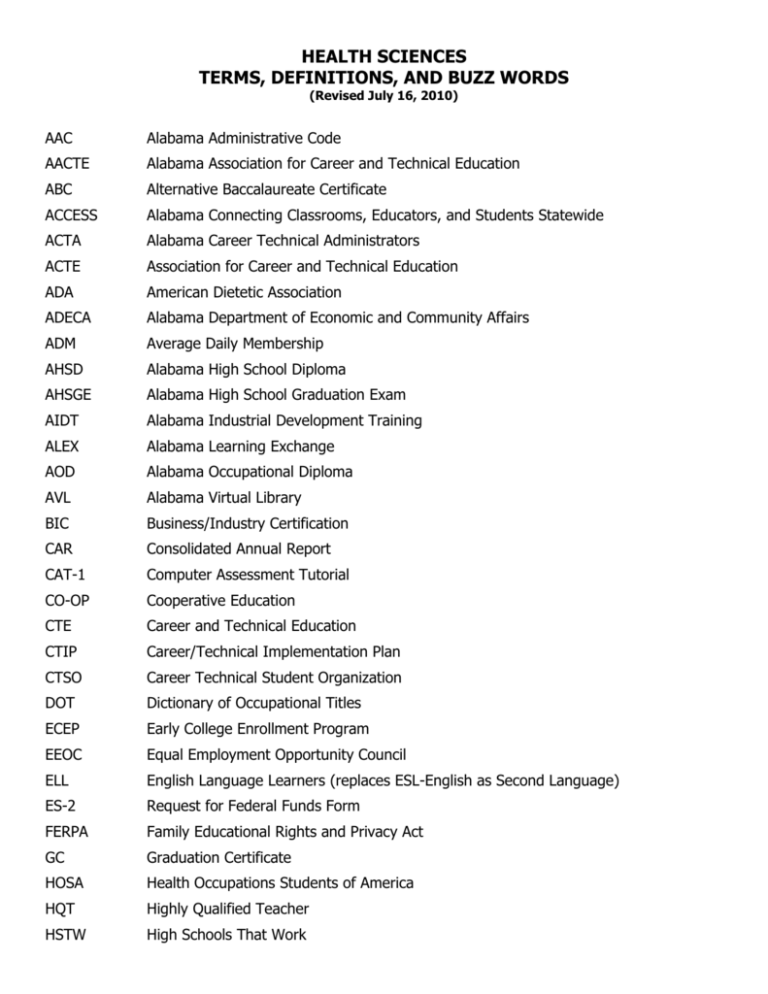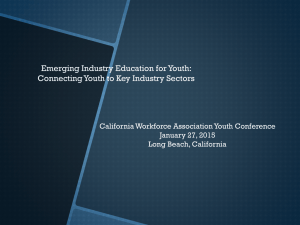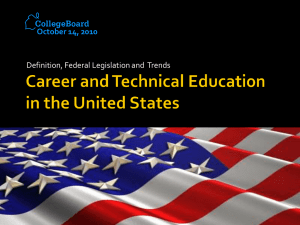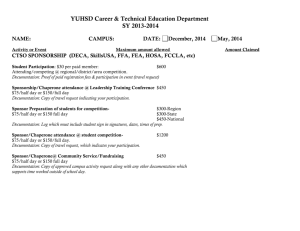Health Science Buzz Words - Alabama Department of Education
advertisement

HEALTH SCIENCES TERMS, DEFINITIONS, AND BUZZ WORDS (Revised July 16, 2010) AAC Alabama Administrative Code AACTE Alabama Association for Career and Technical Education ABC Alternative Baccalaureate Certificate ACCESS Alabama Connecting Classrooms, Educators, and Students Statewide ACTA Alabama Career Technical Administrators ACTE Association for Career and Technical Education ADA American Dietetic Association ADECA Alabama Department of Economic and Community Affairs ADM Average Daily Membership AHSD Alabama High School Diploma AHSGE Alabama High School Graduation Exam AIDT Alabama Industrial Development Training ALEX Alabama Learning Exchange AOD Alabama Occupational Diploma AVL Alabama Virtual Library BIC Business/Industry Certification CAR Consolidated Annual Report CAT-1 Computer Assessment Tutorial CO-OP Cooperative Education CTE Career and Technical Education CTIP Career/Technical Implementation Plan CTSO Career Technical Student Organization DOT Dictionary of Occupational Titles ECEP Early College Enrollment Program EEOC Equal Employment Opportunity Council ELL English Language Learners (replaces ESL-English as Second Language) ES-2 Request for Federal Funds Form FERPA Family Educational Rights and Privacy Act GC Graduation Certificate HOSA Health Occupations Students of America HQT Highly Qualified Teacher HSTW High Schools That Work IC3 Internet and Computing Core Certification IDEA Individuals with Disabilities Education Act IEP Individual Education Program ISO 9001 International Organization for Standardization ISS Information Systems Services IT Information Technology JLDC Joint Leadership Development Conference LEA Local Education Agency LEAPS Local Education Agency Personnel and Subject Codes LEP Limited English Proficiency LMI Labor Market Information NCLB No Child Left Behind NIH National Institutes of Health NOCTI National Occupational Competency Testing Institute NTI New Teacher Institute OCR Office of Civil Rights OSHA Occupational Safety and Health Administration POI Plans of Instruction RTI Response to Instruction SBE State Board of Education SCANS Secretary’s Commission on Achieving Necessary Skills (SCANS Report) SDE Alabama State Department of Education SkillsUSA An Organization for Students in Technical, Skilled, and Service Careers SLEAPS Support Local Education Agency Personnel and Subject Codes SWD Student with Disabilities WBL Work-Based Learning Experiences WIA Workforce Investment Act YESS Youth Education Success System ACCESS (Alabama Connecting Classrooms, Educators, and Students Statewide) – are courses delivered through web-based methodologies consistent with guidelines established by the Department and the local education agency. Accommodations – are procedures and/or activities that are incorporated by the teacher for students with disabilities to lessen the impact of their disability on the instructional process and student achievement. When accommodations are made for students with disabilities, the content standards are the same. Accommodations in secondary coursework may lead to the Alabama High School Diploma or a certificate. Accountability – is the measurement of the educational effectiveness and efficiency of a program. Adjusted Enrollment – an adjustment on the daily schedule enrollment category whereby a student may be counted as two when modifications are required based on a student’s Individualized Education Program (IEP). Alabama Administrative Code (AAC) – is a compilation of the rules of all the state agencies covered by the Alabama Administrative Procedure Act. Alabama Learning Exchange (ALEX) – is an online program used to generate and store lesson plans. Teachers submit lesson plans to the State Department of Education online at www.alsde.edu. Alabama Occupational Diploma (AOD) – is a high school diploma option for students with disabilities as defined by IDEA legislation. This diploma is an exit document for students who have a post-school goal of employment, not further education. Alabama Virtual Library (AVL) – is an Internet library service available to teachers and the public. Alternative Baccalaureate Certificate (ABC) – is a teaching certificate requested for an individual who holds a BS degree from a regionally accredited institution and meets additional Department requirements as outlined in the Career/Technical ABC Summary. Annual Performance Report – is an assessment used to determine activities conducted by Health Sciences teachers during the year who are teaching programs from the Health Sciences Cluster. This data is used for state and federal reports. The report is emailed to teachers at the end of the school year and is due back to the State Department of Education by June 15. Articulated Credit – is secondary credit recognized by the Department of Postsecondary Education for coursework completed by a career and technical education student preventing duplication of coursework, providing students with a non-duplicative sequence of progressive courses, promoting transition to postsecondary education, which can lead to degrees or certificates in a postsecondary tech prep education program. Articulation – Coursework – is a systematic method that prevents duplication within sequences of courses between secondary schools and postsecondary institutions. Equipment – is a written agreement that allows orientation and training on equipment shared by secondary schools, postsecondary institutions, and/or business and industry. Association for Career and Technical Education (ACTE) – is the professional association for the field of Career and Technical Education. The Alabama Association for Career and Technical Education (AACTE) is the state association. Business/Industry Awareness – Activities that provide teachers with new knowledge on content, equipment, or skills related to the career and technical education program resulting in lessons taught to students. Business/Industry Certification (BIC) – is a certification process used by the State Department of Education to promote quality career and technical education programs. BIC provides validation that career and technical education programs comply with and maintain quality standards as agreed upon by business and industry, education professionals, and the Department. (See Career/Technical Education General Program Business/Industry Certification Standards/Quality Factors Checklist) Career Academy – combine key principles of the school-to-career movement integrating academic and career and technical instruction, providing work-based learning opportunities for students, and preparing students for postsecondary education and employment within a personalized learning environment of a small, focused learning community. Teachers and students integrate academic and career and technical classes as a way to enhance real-world relevance and maintain high academic standards. Local employer partnerships provide program planning guidance, mentors, and work internships. Career and Technical Education (CTE) – is a blend of academic, career-specific, general workplace and life skills leading to further education and employment. CTE is an essential component of the secondary curriculum. CTE is a critical element in meeting the needs of students in academic achievement, career exploration, career preparation, and leadership development. CTE in Alabama is organized according to the 16 National Career Clusters. Career Cluster – is a grouping of occupations and broad industries based on commonalities. The 16 national career clusters provide a framework designed to prepare students to transition successfully from high school to employment or further education. Career Objective – is a student’s statement of interest in seeking future employment in a given career cluster, career pathway, and career program. Career Pathway – is a specialized grouping of knowledge and skills within a career cluster. They are sub-groups organized within the 16 Clusters that are based on a set of common knowledge and skills. Pathways contain course offerings which define CTE programs. Career/Technical Education Implementation Plan (CTIP) – is a component of the Individualized Education Program (IEP) for the CTE student with a disability and who needs accommodations and/or modifications in the CTE program. A sample form is provided in the New Teacher notebook. Career Technical Student Organization (CTSO) – is an organization that functions as an integral part of the career and technical education instructional program with state and national affiliation that provides support for skill attainment and leadership development. CTSOs recognized in Alabama are: DECA-An Association for Marketing Students, FBLA-Future Business Leaders of America, FCCLAFamily, Career and Community Leaders of America, FFA-Agriscience Education, HOSA-Health Occupations Students of America, SkillsUSA-Technical Education, TSA-Technology Student Association. Carl D. Perkins Career and Technical Education Act of 2006 – is the federal legislation which has as its purpose to develop more fully the academic, vocational, and technical skills of secondary and postsecondary students who elect to enroll in career and technical education programs. Clinical Experiences – are planned activities (non-paid) promoting the acquisition of knowledge by providing opportunities for the application of theory through assignments in a health care setting such as a hospital, long-term care facility, clinic, community health agency, or other approved health care provider as part of a health science program. Co-curricular – is integrating CTSO activities and student-directed learning experiences into the instructional program. Consolidated Reviews – is a three-year cycle of monitoring by the Alabama State Department of Education teams to ensure compliance with appropriate state and federal laws and regulations. Content Standard – is a statement of what students should know and be able to do at the conclusion of a course. Content standards are listed in the state approved course of study. All content standards must be taught. Content standards listed under a content stem are denoted by a bullet and/or hyphen. This additional content is minimum and must be taught. Examples listed under a content stem clarify the content standards. They do not have to be taught. Course of Study: Career and Technical Education – is an official document from the State Department of Education that provides the framework for CTE in Alabama’s public school. Content standards in the document define the minimum requirements for course offerings and must be taught. Course Syllabus – is the scope and sequence of content being taught in a course. document for required components. See BIC Credentialing – is the process of validating an individual’s knowledge and skills. Credentials – is the documentation validating an individual’s knowledge and skills. Credit Advancement – can be offered to students who exhibit proficiency beyond the level required for all students for an individual course. Credit Advancement is an alternative to the traditional Carnegie Unit approach to course completion if offered by the local school system. Credit Recovery – can be offered to students who have been unsuccessful in mastering content or skills required to receive course credit or earn promotion. Credit Recovery study is based on deficiencies rather than a repeat of the entire course. Students who have not achieved a baseline average of 40 or above (on a 100-point scale) or its equivalent on a locally adopted grading scale must repeat the entire course. CTE Administrator – The chief/assistant administrator responsible for the management of career and technical education programs and supporting activities. See Subject and Personnel Codes for infield requirements. CTE Courses – is coursework that is based on content knowledge and skills from a cluster, pathway, and program. An equivalent of three one-credit courses in a program must be taught within two years. Courses in the new course of study have been defined as: Career Foundation Course: A course developed with content knowledge and skills from all the pathways included in a cluster. Also, this course contains career and technical education “core elements” and may be a program prerequisite. Program Course: A course that contains specialized content knowledge and skills related to a career and technical education program. CTE Elective: Is any career and technical education course that is not included as one of the Program courses. CTE Course Syllabus – is an instructional plan that provides the student with information related to the CTE course. Certain components of the syllabus are required for Business and Industry Certification. (See handout Components for Instructional Planning) Course Syllabus Course Title Course Description Prerequisite(s) Program Course Goal(s) Essential Question(s) Course Outline Culminating Product(s) Assessment Procedures Grading Scale CTSO Available Student Industry Credential(s) CTE Lesson Plan – is a plan created by the CTE teacher that describes the why, what, how, and when the course content will be taught. Lesson plans are developed around units. The duration of a lesson plan may be 3 – 5 days. Certain components of the lesson plan are required for Business and Industry Certification. (See handout Components for Instructional Planning) Lesson Plan (Includes all ALEX Lesson Plan components and additional CTE components ) Title Overview/Annotation Content Standard(s) National/Other Standards Primary Learning Objectives Additional Learning Objectives (Optional) Total Duration Materials and Equipment Technology Resources Needed Background/Preparation Procedures/Activities Assessment Strategies Extension (Optional) Remediation Accommodation Essential Questions CTSO Activity Course/Program Culminating Product CTE Program – is an area of study that blends academic, occupational, and life skills leading to a credential, employment, or further education. Program components include an SDE-approved curriculum, equipment, and facilities; engaged business partners; and appropriately certified teachers utilizing a program of study. CTE Program Grid – a document that lists the cluster, pathways, and programs in career and technical education. CTE Students – Students enrolled in CTE courses are classified as: Participant – is a student earning a half or one credit in a CTE course. Concentrator – is a student earning two credits in a CTE program. Courses with prerequisites must be taken sequentially. Completer – is a student earning concentrator status in a CTE program and one additional CTE credit. Dual Enrollment – is concurrent enrollment in both secondary and postsecondary education for the purpose of receiving credit. See Alabama Administrative Code, Chapter 290-3-1-.02. Early College Enrollment Program (ECEP) – is a dual enrollment program designed to enable qualifying high school juniors and seniors to earn credits applicable toward high school graduation and career degree requirements. Embedded Credit – is credit awarded for satisfactory completion of a designated CTE program containing embedded academic content. Embedded Credit must be approved by the State Department of Education and the Local Education Agency. English Language Learner – is a student who has limited or no ability in speaking, reading, writing, or understanding the English language, and whose native language is not English or who lives in a family/community setting where the dominant language is not English. Enrollment Data – is information needed to measure performance of programs. This data consists of student demographics, academic and skill attainment, completion, and placement (follow-up). Extended Contract – is the time that a career and technical education teacher is employed by the LEA beyond a 187-day contract. First Choice – was adopted by the Alabama State Board of Education in May 2008 and strives to enable every high school student to reach his/her full potential. First Choice was designed to strengthen the curriculum for Alabama high schools and provides numerous safeguards to assist those who struggle academically. Such measures help guide students toward a quality education and obtaining a high school diploma. Follow-Up Report – is documentation of student program completion and successful transition to postsecondary education or advanced training, employment, and/or military service. Health Occupations Students of America (HOSA) – is the career and technical education student organization for the Health Sciences Cluster. Health Science Cluster – provides students with essential knowledge and skills for pursuing a career in health care. Students choose one of five Health Science pathways―Therapeutic Services, Diagnostic Services, Health Informatics, Support Services, or Biotechnology Research and Development. The required foundation course, Foundations of Health Science, is offered to all ninththrough twelfth-grade students. This course, a prerequisite to all courses, provides essential health care knowledge and skills and promotes the application of science and technology. All pathways in the cluster lead to a degree or certificate at the postsecondary level. Health Science Education – is the unit name at the State Department of Education that manages the Health Science Cluster. Health Science is an occupational career and technical program that introduces concepts common to a variety of clinical disciplines and includes understanding of professional and ethical behavior. Development of leadership skills is enhanced through student participation in Health Occupations Students of America (HOSA). Health Science Section of ACTE/AACTE – is the Health Sciences program area section of the Association for Career and Technical Education and the Alabama Association for Career and Technical Education. High Schools That Work (HSTW) – is the largest and oldest of the Southern Regional Education Board’s (SREB) seven school-reform initiatives for high school and middle school grades. The framework of goals and key practices is established to raise student achievement. Highly Qualified Teacher (HQT) – is a teacher who has met the criteria as outlined in the NCLB Act of 2001. To be deemed highly qualified, teachers must have: 1) a bachelor’s degree, 2) full state certification or licensure, and 3) proof that they know each subject they teach. Public elementary and secondary school teachers who teach a core academic subject must be highly qualified by 20052006. Core academic subjects include English, reading or language arts, mathematics, science, foreign languages, civics and government, economics, arts, history, and geography. (Title IX, Part A, Section 23 of NCLB Act of 2001) A person that has received certification through the National Board for Professional Standards is also considered highly qualified. Career and technical teachers who have certification in their program area where they teach are highly qualified. Teachers teaching embedded or substitute credit must hold a Class B or higher certificate in the area and be highly qualified in the embedded or substitute core subject area. Individualized Education Program (IEP) – is a formalized plan, mandated by state and federal legislation, detailing the educational experiences and course offerings of each special needs student. Individualized Education Program (IEP) Team – is a group who works together to ensure that each student with a disability(s) has equal opportunity to access the full range of the education agency's career and technical education programs, including occupationally specific courses of study, cooperative education, and apprenticeship programs. A representative of career and technical education must be included as a member of the IEP Team for those children with disabilities who have been referred for, or are currently receiving career and technical education. Interest Inventory – is a self-assessment tool that measures interest in a broad range of occupations, work activities, leisure activities, and school subjects. Internship – are non-paid work experiences. Joint Leadership Development Conference (JLDC) – is an annual event that provides opportunities for students and advisors from career and technical and other student organizations to network, develop leadership and teamwork skills, and learn strategies for personal and chapter growth. Live Work (Paid or Non-Paid) – is work presented from outside the classroom (may be from community sources, school-based projects, etc.) to be conducted by students that relates to the knowledge and skills taught as part of a career and technical education program. Local Education Agency Personnel and Subject Codes (LEAPS) – is a report completed annually by the local school system for certified personnel that contains personal information, daily schedules, and funding data. Maintenance Funds – is local financial support for maintenance provided in an amount not less than $300 per teacher, plus not less than $3 per student based upon enrollment. Alabama Administrative Code 290-6-1-.08(1)(6). Funding will be provided to all career and technical teachers based on the previous year’s program enrollment. Modifications – are changes made to course content. When course content is modified, the student is not pursuing the required content standards for completion of CTE programs. In order for any student (including a student with disabilities) to earn credit that can be applied toward obtaining an Alabama High School Diploma, the content that is prescribed in the applicable Alabama course of study must be taught. If the prescribed content is not taught, then credit may not be given for this course toward the regular Alabama High School Diploma. Modifications can only be made for students seeking certificates of attendance, not for students seeking diplomas. National Consortium for Health Science Education – is a national partnership of individuals and organizations with a vested interest in health science education. The consortium was organized in 1991 to stimulate creative and innovative leadership for ensuring a well prepared healthcare workforce. In April 2009, the name of the consortium was officially changed to the National Consortium for Health Science Education (NCHSE). National Healthcare Foundation Standards and Accountability Criteria – is a national document that offers an answer to the question, “What does a worker need to know and be able to contribute to the delivery of safe and effective healthcare?” The standards represent core expectations most workers need to succeed in health careers. Benefits of having nationally validated healthcare skill standards include potential to forge strong links among various stakeholders. The foundation standards provide a common language, common goal, and a common reference point for educators, employers and consumers. New Teacher Institute (NTI) – is an institute provided by the State Department of Education for new teachers. Professional development activities are provided to new teachers to meet requirements for a Career and Technical Education Certificate endorsed in technical education or health science education, or a Career and Technical Alternative Baccalaureate Certificate. These activities orient them to CTE teachers’ tasks and responsibilities. No Child Left Behind Act of 2001 (NCLB) – is a reauthorization of the Elementary and Secondary Act (ESEA) of 1965. Four major pillars are: stronger accountability for results, more freedom for states and communities, proven education methods, and more choices for parents. Plans of Instruction (POI) – is an instructional plan used to create units of instruction included in a CTE course. Plans of Instruction provide teachers with suggestions of information that may be included in their lesson plans. Plans of Instruction have been developed for all but three courses included in the Health Sciences Cluster. The following components are included on the Plans of Instruction: Plans of Instruction: Course Title Unit Content Standard(s) Learning Objective(s) Essential Question(s) Content Knowledge Suggested Instructional Activities Suggested Materials, Equipment, and Technology Resources Unit Assessment Unit/Course CTSO Activity Unit/Course Culminating Product Course/Program Credential(s) Positive Placement – is the placement of program completers in employment in-field or related field, continuing education, or military service. Postsecondary Education – is education beyond/after high school that includes enrollment and participation at two- and four-year institutions, apprenticeship training, life-long learning opportunities, and work requiring sustained certifications. Prerequisite – is a course that a student must complete in order to progress to the next course. Preventive Maintenance – are written procedures to minimize equipment downtime. Professional Development – is the process of improving staff skills and competencies needed to produce outstanding educational results for students. High-quality professional development (NCLB) is the process of developing teacher competencies regarding rigorous and relevant content, strategies, and organizational supports that ensure the preparation and career-long development of teachers and others whose competence, expectations, and actions influence the teaching and learning environment. Program Advisory Committee – is a consulting body used by the Health Sciences teacher to assist in public relations, curriculum design, equipment selections, program evaluation, and other related activities. The committee meets at least twice a year and has a minimum of five members. The committee is broadly based and includes individuals from business, industry, and the community. (See Advisory Committee/Council Handbook) Program of Work – is an organized list of tasks and objectives that includes time lines, activities, responsibilities, and evaluations. Project-Based Learning – is an instructional strategy that is based on a concern, issue or essential question that students address through various learning activities and assessments. Response to Instruction (Rti) – is an SDE initiative that focuses on academic and behavioral strategies in the general education setting. The expectation is that K-12 general education teachers teach in a way that meets the varied needs of their students, utilizing ongoing assessments to identify students in need of additional instructional support as early as possible. District and school leaders are encouraged to organize school resources so that students receive instructional support in a timely manner. A problem-solving process should be used to assist the classroom teacher in designing and selecting strategies for improving student academic and/or behavioral performance. The purpose of the problem-solving process is to develop academic and behavior intervention strategies that have a high probability of success. Safety Assessment – is the means of determining that students can perform at a proficient level (100%) regarding safety requirements of the career and technical program. Safety Policy – is a local board approved plan of action clearly outlining student and staff responsibilities ensuring that policies and procedures are in place regarding potentially dangerous or hazardous situations. Subject and Personnel Codes – are codes used to identify CTE course offerings and used for data collection. (See 2010-2011 Subject and Personnel Codes) Substitute Credit – is credit awarded for satisfactory completion of a CTE course that contains identical content of an academic content course. Substitute Credit must be approved by the State Department of Education and the Local Education Agency. Talents – is the State Department of Education statewide marketing campaign. campaign includes a Talents logo. The marketing Tech Prep – is a combination of at least two years of secondary education with at least two years of postsecondary education in a non-duplicative, sequential course of study based on the recommended career and technical education secondary program.







